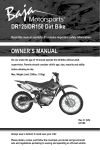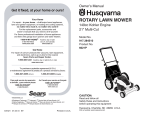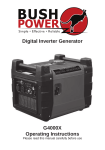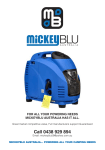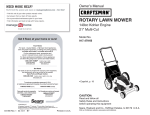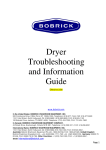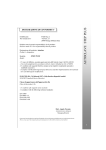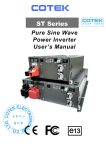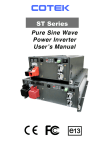Download Bush Power G3000X Operating instructions
Transcript
Digital Inverter Generator G3000X Operating Instructions Please read this manual carefully before use Thank you for purchasing our generator. This manual covers operation and maintenance of the G3000X. All information in this publication is based on the latest product information available at the time of approval for printing. We reserve the right to make changes at any time without notice and without incurring any obligation. The copyright of this manual belongs to our company, no part of this publication may be reproduced without written permission. This manual should be considered a permanent part of the generator and should remain with it if it is resold. Pay special attention to statements preceded by the following words WARNING It indicates a strong possibility of severe personal injury or death if instructions are not followed. CAUTION It indicates a strong possibility of severe personal injury or death if instructions are not followed. If a problem should arise, or if you have any questions about the generator, consult an authorized dealer. BE CAREFUL The generators are designed to give safe and dependable service if operated according to instructions. Read and understand the Owner’s Manual before operating the generator. Failure to do so could result in personal injury or equipment damage. WARNING The generator is designed to give safe and dependable service if operated according to instructions. Read and understand this manual carefully before operating the generator, or it may cause serious injury and equipment damage. WARNING Exhaust contains poisonous carbon monoxide. Do not operate generator in confined environment or with an aerator. Only use outdoors and far from open windows doors and vents. WARNING The muffler becomes very hot during operating and remains hot for a while after stopping the engine. Be careful not to touch the muffler while it is hot. Let the engine cool before storing the generator indoors. The engine exhaust system will be heated during operation and remain hot immediately after stopping the engine. To prevent scalding, pay attention to the warning marks attached to the generator. WARNING Gasoline is extremely flammable and is explosive under certain conditions. Refuel in a ventilated area with engine stopped. Keep away from cigarettes, smoke and sparks when refuelling the generator. Always refuel in a well-ventilated location. WARNING Connection for standby power to a building electrical system must be made by a qualified electrician. The connection must isolate the generator from utility power, and must comply with all applicable laws and electrical codes. Improper connections to a building electrical system can allow electrical current from the generator to backfeed into the utility lines. Such backfeed may electrocute utility company workers or others who contact lines during a power outage, and the generator may explode, or cause fires when utility power is restored. WARNING To avoid accidents and equipment damage, check generation system every time before starting engine. Keep the generator a distance at least 1 meter from other equipment during operation. Keep the generator upright when running. If generator is tilted, it may cause fuel spillage. Generator operators must be trained, must know how to stop the generator quickly and understand the operation of all controllable parts. Untrained operators should not be allowed to use this equipment. Keep children and pets away from operating area. Keep away from rotating parts during operation. The generator is a potential source of electrical shock when misused. Do not operate it with wet hands or in any wet location. Do not operate the generator in rain or snow, or let it get wet. WARNING Read this manual carefully before using the machine, for your own safety. You should only use the generator according to these instructions. COMPONENT IDENTIFICATION 1. Fuel cap 2. Air vent knob 3. Choke knob 4. Control panel 5. Starting grip 6. Fuel valve grip 7. Maintenance cover 8. AC socket 9. Overload indicator light 10. Output indicator light 11. Oil alert indicator light 12. Eco throttle switch 13. Engine switch 14. DC socket 15. DC circuit breaker 16. Grounding terminal CONTROL PANEL SMART THROTTLE Engine speed is kept at idle automatically when the electrical appliance is disconnected and it returns to the required speed to power the electrical load when the electrical appliance is connected. This position is recommended to minimize the fuel consumption while in operation. CAUTION Smart throttle system does not operate effectively if the electrical appliance requires instant or momentary power. When high electrical loads are connected simultaneously, turn the Smart throttle switch to the OFF position to reduce voltage vibration. In DC operation, turn the Smart throttle switch to the OFF position. SAFETY INSTRUCTIONS • • • • • • • • • • • • • • • • • • The generator is designed to give safe and dependable service if operated according to instructions.. Read and understand the Owner’s Manual before operating the generator. Failure to do so could result in personal injury or equipment damage. Exhaust gas contains poisonous carton monoxide. Never run the generator in an enclosed area. Be sure to provide adequate ventilation. The muffler becomes very hot during operation and remains hot for a while after stopping the engine. Be careful not to touch the muffler white it is hot. Let the engine cool before storing the generator indoors. The engine exhaust system will be heated during operation and remain hot immediately after stopping the engine. To prevent scalding, pay attention to the warning marks. Gasoline is extremely flammable and explosive under certain conditions. Refuel in a well ventilated area with the engine stopped. Keep away from cigarettes, smoke and sparks when re-fuelling the generator. Always refuel in a well ventilated location. Clean up spilled gasoline at once. Connections for standby power to a building’s electrical system must be made by a qualified electrician and must comply with all applicable laws and electrical codes. Improper connections can allow electrical current from the generator to back feed into the utility lines. Such back feed may electrocute utility company workers or others who contact the lines during a power outage, and when utility power is restored, the generator may explode, burn, or cause fires in the building’s electrical system. Always make a pre-operation inspection before you start the engine. You may prevent an accident or equipment damage. Place the generator at least 1m (3ft) away from buildings or other equipment during operation. Operate the generator on a level surface. If the generator is tilted, fuel spillage may result. Know how to stop the generator quickly and understand the operation of all the controls. Never permit anyone to operate the generator without proper instructions. Keep children and pets away from the generator when it is in operation. Keep away from rotating parts while the generator is running. The generator is a potential source of electrical shocks when misused; do not operate with wet hands. Do not operate the generator in rain or snow and do not let it get wet. SAFETY LABEL LOCATIONS These labels warn you of potential hazards that can cause serious injury. Read the labels, safety notes and precautions described in the manual carefully. If a label comes off or becomes hard to read, contact your dealer for a replacement. PRE-OPERATION CHECK Be sure to check the generator on a level surface with the engine stopped. Check the engine oil level Using non-detergent oil or 2-stroke engine oil could shorten the engine’s service life. Use high-detergent, premium quality 4 –stroke engine oil, certified to meet or exceed .SF.(15W40) Select the appropriate viscosity for the average temperature in your area. SAE Viscosity Grades Loosen the cover screw and remove the left side maintenance cover. Remove the oil filler cap, and wipe the dipstick with a clean rag. Check the oil level by inserting the dipstick in the filler hole without screwing it in.. If the oil level is below the end of the dipstick, refill the recommended oil up to the top of the oil filler neck. The Oil Alert System will automatically stop the engine before the oil level falls below the safe limit. However, to avoid the inconvenience of an unexpected shutdown, it is still advisable to visually inspect the oil level regularly. Check the fuel level Turn the fuel cap lever to “OFF” position before transporting. Use automotive fuel (Unleaded or low leaded is preferred to minimize combustion chamber deposits). !! Don’t use fuel containing ethanol or alcohol: Fuel system damage or engine performance problems resulting from the use of fuels that contain ethanol or alcohol are not covered under the warranty. Never use an oil/gasoline mixture or dirty gasoline. Avoid getting dirt, dust or water in the fuel tank. After refuelling, tighten the fuel filler cap securely. Gasoline is extremely flammable and is explosive under certain conditions. Refuel in a well-ventilated area with the engine stopped. Do not smoke or allow flames or sparks in the area where the engine is refuelled or where gasoline is stored. Do not overfill the fuel tank. After refuelling, make sure the tank cap is closed properly and securely. Be careful not to spill fuel when refuelling. Spilled fuel or fuel vapour may ignite. If any fuel is spilled, make sure the area is dry before starting the engine. Avoid repeated or prolonged contact with skin or breathing of vapour. KEEP OUT OF REACH OF CHILDREN Check the air cleaner Check the air cleaner element to be sure it is clean and in good condition. 1. Loosen the cover screw and remove the left side maintenance cover. 2. Press the latch tab on the top of the air cleaner body, remove the air cleaner cartridge, and check the element. 3. Clean or replace the element if necessary. Never run the engine without the air cleaner. Rapid engine wear will result from contaminants, such as dust and dirt, being drawn through the carburettor, into the engine. It is normal for a little oil to appear under the air filter box if the generator is running for a long period of time, or a lot of oil is in the engine. Wipe up excess oil after each use and after stopping the generator. GENERATOR USE Starting the engine Before starting the engine, disconnect any load from the DC receptacle. 1. Turn the fuel cap lever fully clockwise to the ON position. 2. Set the fuel valve in the “ON” position 3. Choke(Type 1) To start a cold motor shove the choke lever all the way to the left. To restart a hot motor set the choke lever half-way. 4. Choke(Type 2) To start a cold motor pull out the choke completely to close. To restart a hot motor, press the choke completely to open. Choosing the right choke position is the key to starting the motor. You may have to practise a few times to use the choke correctly Shove the choke completely to the right to restart a hot motor. Shove the choke to about halfway to restart a warm motor. A hot motor will not start if there is too much fuel in the cylinder. If this happens, wait five to ten minutes before trying again. Shove the choke completely to the right and the motor should start. 4. Set the motor switch in the “ON” position 5. Pull slightly on the start cord until you feel resistance and then yank hard and swiftly. Do not let the start cord retract by itself: guide it back by hand. Hold the carrying handle firmly to prevent the generator from falling over when you pull the start cord. 6. After the engine starts, allow the engine to run continuously and warm up. 7. Press the choke in completely after the engine is started. If the engine stops and will not restart, check the engine oil level before troubleshooting in other areas. Before using the device once it is connected, switch off the ECO switch. Remote Control Stop Start Button Press twice to begin operation Starting Key The generator can be started by either the remote control or the starting key. • • • When starting the generator with the starting key, do not use the remote to stop the generator. When starting the generator with the remote, do not use the starting key to stop the generator. The emergency stop button can be used to stop the generator, regardless of how it has been started. High Altitude Operation At high altitude, the standard carburettor air –fuel mixture will be excessively rich. Performance will decrease, and fuel consumption will increase. High altitude performance can be improved by installing a smaller diameter main fuel jet in the carburettor and readjusting the slow tempo screws. If you always operate the generator at altitudes higher than 1,500m (4,000 feet) above sea level, have your dealer perform these carburettor modifications. Even with suitable carburettor jetting, engine horsepower will decrease approximately 3.5% for each 300m (1,000 feet) increase in altitude . The effect of altitude on the horsepower will be greater than this if no carburettor modification is made. Operation of the generator at an altitude lower than the carburettor is jetted for may result in reduced performance, overheating , and serious engine damage caused by an excessively lean air/fuel mixture. Warning • • • • • • To prevent electrical shock from faulty appliances , the generator should be grounded. Connect an electric conductor (cable) of at least 1.5mm2 between the generator’s ground terminal and an external ground source. Connections for standby power to a building’s electrical system must be made by a qualified electrician and must comply with all applicable laws and electrical codes. Improper connections can allow electrical current from the generator to back feed into the utility lines. Such back feed may electrocute utility workers before power is restored, the generator may explode, burn, or cause fires in the building’s electrical system. Do not exceed the current limit specified for any one receptacle Do not connect the generator to a household circuit. This could cause damage to the generator or to electrical appliances in the house. Do not modify or use the generator for any purpose other than it is intended for. Also observe the following when using the generator. —Do not connect generators in parallel. —Do not connect an extension to exhaust pipe. When an extension cable is required, be sure to use a rubber sheathed flexible cable, • • • • Limit length of extension cables 60m for cables of 1.5mm2 and 100m for cables of 2.5mm2. Keep the generator away from other electric cables or wires such as distribution network. The DC receptacle can be used while the AC power is in use. If you use both at the same time, be sure not to exceed the total power for AC and DC. Most appliance motors require more than their rated wattage for startup. AC applications 1. Start the engine and make sure the output indicator light (green) illuminates. 2. Confirm that the appliance to be used is switched off, and plug it in to the generator. • • Substantial overloading that continuously lights the overload indicator light (red) may damage the generator . Marginal overloading that temporarily lights the overload indicator light (red) may shorten the service life of the generator. Be sure that all appliances are in good working order before connecting them to the generator, if an appliance begins to operate abnormally, becomes sluggish, or stops suddenly, turn off the generator engine switch immediately. Then disconnect the appliance, and examine it for signs of malfunction. Output and Overload Indicators The output indicator light (green) will remain lit during normal operating conditions. If the generator is overloaded or if there is a short in the connected appliance, the output indicator light (green) will turn OFF, the overload indicator light (red) will turn ON and current to the connected appliance will be shut off. Stop the engine if the overload indicator light (red) switches ON and investigate the overload source. Before connecting an appliance to the generator, check that it is in good order, and that its electrical rating does not exceed that of the generator. Then connect the power cord of the appliance , and start the engine. Be sure all equipment is turned off before plugging in the power cord. When an electric motor is started, both the overload indicator light (red) and the output indicator light (green) may go on simultaneously. This is normal if the overload indicator light (red) goes off after about four seconds. If the overload indicator light (red) stays on, consult your dealer. 1. Connect the ground terminal 2. Start engine according to “STARTING THE ENGINE” When the output indicator light (green) does not light and the overload indicator light (red) lights instead, set the engine switch to STOP, stop the engine at once and then start the engine again. 3. Confirm that the equipment to be used is switched off, and insert the plug of the equipment to be used into the AC receptacle unit A. Check that the equipment to be connected is switched off. When the equipment to be used is switched on, it will operate suddenly, and injuries or accidents may be caused. 4. Switch on the equipment output indicator light will light up. In case of overload operation or when trouble occurs for the equipment being used, the output indicator light (green) will go out, the overload indicator light (red) will light continuously, and no power will be put out. At this time, the engine will not stop, so that the engine must be stopped by setting the respective engine switch to STOP. When equipment requires a large starting power, the overload indicator lights (red) and the output indicator light (green) may light together for a short time, but this is no abnormality. After start of the equipment, the overload indicator light (red) will go out after about 5 seconds and the output indicator light (green) will stay lit. AC Electric lamps Power factor 1 Power tools 0.8-0.9 Electromotor G3000X 0-2000W 0-1000w 0-3000W DC battery 0.4-0.7 (efficiency 0.86) Rated voltage 12V DC Applications For charging 12V automotive batteries: Opening the smart throttle Closing the smart throttle DC Max. output power Idling voltage (V) 22 27 37 Loading voltage (V) 12 13 13.5 Loading current (A) 6 8.5 8.5 The generator cannot sense a sensibility load with the same power which the manual indicates. It only can sense 40%-70% power which the manual indicates. Example: Model G3000X Generator rated output Frequency Power factor AC 1.0 0.4-0.75 DC 3000VA 2500W 0-920W~1725W 100W (12V/8.3A) • • • • • • • • • • When using the DC output, turn Smart Throttle to the OFF position. The DC current will be below 5A if turning on the Smart Throttle without AC current output. When charging batteries, person must be present to monitor the voltage. Stop charging when the voltage of the batteries is above 16V. Or it may cause battery explosion, resulting in serious injury or death. To prevent the possibility of creating a spark near the battery, connect charging cable first to the generator, then to the battery. Disconnect cable first at the battery. Before connecting charging cables to a battery that is installed in a vehicle, disconnect the vehicles grounded battery cable. Reconnect the vehicle’s grounded battery cable after the charging cables are removed. This procedure will prevent the possibility of short circuit and sparks if you make accidental contact between a battery terminal and the vehicle’s frame or body. Do not attempt to start an automobile engine while the generator still connected to the battery. The generator may be damaged. ·Connect the positive battery terminal to the positive charging cord. Do not reverse the polarity of the charging cables, or serious damage to the generator and/or the battery may occur. The battery may give off explosive gases; keep spark, flames and cigarettes away. Provide adequate ventilation when charging. The battery contains sulphuric acid (electrolyte). Contact with skin or eyes may cause severe burns. Wear protective clothing and a face shield. If electrolyte gets on your skin, flush with water. If electrolyte gets in your eyes, flush with water for at least 15 minutes • • • and call a physician. Electrolyte is poisonous. If swallowed, drink large quantities of water or milk and follow with milk or magnesia or vegetable oil and call a physician. KEEP OUT OF THE REACH OF CHILDREN, PETS AND UNTRAINED PEOPLE. DC Overload • • The DC receptacle may be used while the AC power is in use. An overloaded DC circuit will trip the DC circuit breaker. If this happens, disconnect the DC load before pushing in the circuit breaker to resume operation. Oil alert system • • The oil alert system is designed to prevent engine damage caused by an insufficient amount of oil in the generator engine. The alert system will automatically shut down the engine if it senses low oil levels (the engine switch will remain in the ON position). If the oil alert system shuts down the engine, the oil alert indicator light (red) will come on when you operate the starter, and the engine will not run. If this occurs, add engine oil. Stopping the engine To stop the engine in an emergency, turn the engine switch to the OFF position. In normal use: 1. Switch off the connected equipment and pull the inserted plug out. 2. Turn the engine switch to the OFF position. 3. Turn the cap level fully counter clockwise to the “OFF” position. Be sure both the fuel cap lever and the engine switch are in “OFF” position when stopping, transporting and/or storing the generator. Maintenance • • The purpose of the maintenance and adjustment schedule is to keep the generator in the best operating condition. Inspect or service as scheduled in the table below Shut off the engine before performing any maintenance ,If the engine must be run, make sure the area is well ventilated, The exhaust contains poisonous carbon monoxide gas. Use authorized parts or their equivalent. The use of replacement parts which are not of equivalent quality may damage the generator. Maintenance Schedule Note 1. Log hours of operation to determine proper maintenance. 2. Service more frequently when used in dusty areas. 3. These items should be serviced by an authorized dealer, unless the owner has the proper tools and is mechanically proficient. See the Shop Manual. Temperature (℃) 25 30 35 40 Time for changing oil (hour) Normal 18 15 12 Recommended power factor 100% 95% 85% 70% Changing oil Drain the oil while the engine is still warm to assure rapid and complete draining. Make sure to turn the engine switch and the fuel cap vent lever OFF before draining. 1. Lean the generator. 2. Fasten the oil lead pipe on the oil exhaust as the picture. Then pour out the oil. 3. Refill the new oil and check the oil position in the crankcase with the dip stick 4. After refill the new oil into the crankcase , please shake the generator left to right some times and make sure the bobber of the oil alarm system is floating. 5. Reinstall the side maintenance cover and tighten the cover screw securely. Wash your hands with soap and water after handing used oil. Please dispose of used motor oil in a manner that is responsible with the environment in mind. We suggest you take it in a sealed container to your local service station for reclamation. Do not throw it in the trash or pour it on the ground. Air Cleaner Service A dirty air cleaner will restrict air flow to carburettor. To prevent carburettor malfunction, service the air cleaner regularly. Service more frequently when operating the generator in extremely dirty areas. Do not use gasoline or low flash point solvents for cleaning. They are flammable and explosive under certain conditions. 1. Loosen the cover screw and remove the access panel. 2. Remove the screw under the air filter case. 3. Pull the air filter cartridge down 30mm and remove the air filter cartridge. 4. Remove the air filter iron clip and check the air filter element. Clean or replace the element if necessary. 5. Reinstall the air filter parts after cleaning or replacing air filter element. Spark Plug Servicing Please use high quality authentic spark plugs. To ensure proper engine operation, the spark plug must be properly gapped and free of deposits. 1. Remove the bolts on the top maintenance cover and the cover. 2. Take out the ignition coil rubber boot. 3. Remove the spark plug with the spark plug wrench. 4. Visually inspect the spark plug. Discard it if the insulator is cracked or chipped. Clean spark plug with a wire brush if it is to be reused. 5. Install the spark plug carefully by hand, to avoid cross-threading. 6. After a new spark plug has been seated by hand, it should be tightened 1/2 turn with a wrench to compress its washer. If a used plug is being reinstalled, it should only require 1/8 to 1/4 turns after being seated. 7. Reinstall the ignition coil rubber boot on the spark plug securely. 8. Reinstall the cover panel. The spark plug must be securely tightened. An improperly tightened plug can become very hot and possibly damage the generator. Never use a spark plug with an improper heat range. Never use a spark plug without damping resistance, or it will cause no AC output. Transporting and Storage To prevent fuel spillage when transporting or during temporary storage, the generator should be secured upright in its normal operating position, with the engine switch OFF. The fuel cap vent lever is turned counter clockwise to the OFF position. Allow the engine to cool well before turning the fuel cap vent lever to the OFF position, When transporting generator: • • • • Do not overfill the tank (there should be no fuel in the filler neck). Do not operate generator while it is on a vehicle. Take the generator off the vehicle and use it in a well-ventilated place. Avoid a place exposed to direct sunlight when putting the generator on a vehicle. If the generator is left in an enclosed vehicle for many hours, high temperature inside the vehicle could cause fuel to vaporize resulting in a possible explosion. Do not drive on a rough road for an extended period with the generator on board. If you must transport the generator on a rough road, drain the fuel from the generator beforehand. Before storing the unit for an extended period: 1. Be sure the storage area is free of excessive humidity and dust. 2. Drain the fuel. Gasoline is extremely flammable and explosive under certain conditions. Do not smoke or allow flames or sparks in the area. 3. Completely drain the fuel from the tank. Open the fuel valve, start the engine and operate it in the idle position until all remaining fuel is gone and the engine stops automatically. 4. Discharge oil. 5. Remove spark plug and fill cylinder with 2cc’s fresh oil. Pull start motor 3-4 times to discharge the remaining oil. Then reinstall the spark plug. 6. Pull the starting cord slowly until resistance is strong . At this time, the piston is moving to the top of the compression stroke and the valves will be closed. Fire arrestor service Uncleaned muffler will increase noise and affect the engine’s running. Clean and maintain the fire arrestor regularly to make sure the generator works normally. The fire arrestor needs cleaning frequently if you use the generator in very dirty conditions, or replace the fire arrestor if necessary. • • Before cleaning the fire arrestor make sure the generator is OFF Before the check and maintenance of the fire arrestor, make sure the machine is cool, otherwise it will cause scalding by the hot muffler. 1. 2. 3. 4. Remove the M6 screws and open the muffler cover. Remove two M4 screws on the fire arrestor. Take down the fire arrestor as per the following figure. Check the fire arrestor, clean or replace it if necessary. TROUBLESHOOTING • • • Shake the generator several times from side to side to make the oil float rise if the generator cannot start after adding oil for the first time and the oil alarm indicator stays on when pulling the starting grip. Make sure there is no spilled fuel around the spark plug. Spilled fuel may ignite. If the engine still doesn’t start, have the generator repaired by a licensed repair person. INSPECTION: 1. Remove the spark plug rubber boot and clean any dirt from around the spark plug 2. Remove the spark plug and place it in the spark plug rubber boot. 3. Connect the side electrode of the spark plug to the metal parts of the engine. 4. Pull the starting cord. A spark could jump across the gap. The equipment that connects generator doesn’t start There is no power in the direct current electric outlet There is no power in the DC electric outlet Deficient AC output Specifications Item L x W x H(mm) Net weight(kg) G3000X 580 x 320 x 510 26 Engine Specifications Item Model Type Displacement Compression ratio Engine speed Cooling system Ignition system Oil capacity Fuel tank capacity Spark plug Noise level(4m) G3000X 157F 4-stroke, OHV, 1-cylinder 149CC 9.2:1 5000rpm(ECO switch is off) Forced air cooling TDI 0.45L 7L A7RTC 94db Generator Specifications Type Item AC output Rated voltage (V) Rated frequency(HZ) Rated current(A) Rated output(KVA) Maximum output(KVA) Maximum output(KVA) Rated voltage(V) Rated current(A) DC output (For 12V automotive batteries only) Part Number G3000X 110/120/220/230/240 50/60 24/22/11.3/10.8 2.8 2.1 2.1 12 8.3 Wiring Diagram Exploded Parts View Bush Power - Warranty Against Defects Procedure Bush Power A subsidiary of The Matson Group Pty Ltd 100 Links Rd, St Marys, NSW 2760 Phone: 02 98333444 Email: [email protected] www.matson.com.au Warranty Bush Power warrants its products to be free of defects for reasonable consumer use for a period of 12 months. Bush Power will repair or replace the warranted product and it will return the repaired products under warranty to the consumer at Bush Power’s cost. To make a claim under this warranty, the consumer must: • advise Bush Power of the defect as soon as it becomes apparent within 12 months of the purchase date and obtain a return authority by phoning Bush Power on the above number. • provide satisfactory proof of purchase; and • send the faulty item to the address supplied above. Exclusions from Warranty This warranty does not apply to products where: • there is evidence of Improper maintenance or abuse to the products; • the products have been exposed to harsh environmental conditions or those outside the specified operating conditions; • Unauthorised modification is evident to the products or misuse of products; • Operation outside the products specification. Warranty Disclaimers Bush Power’s liability in respect of a breach of a consumer guarantee or any warranty made under these warranty terms and conditions for any products not of a kind ordinarily acquired for personal, domestic or household use is limited, in relation to the products to the extent permissible by law and at it’s option to: • replacing the products or the supply of equivalent goods; • the repair of the products; • the payment of the cost of replacing the products or of acquiring equivalent goods; or • the payment of the cost of having the products repaired. To the extent permitted by law, all other warranties whether implied or otherwise, not set out in these warranty terms and conditions are excluded and we are not liable in contract, tort (including, without limitation, negligence or breach of statutory duty) or otherwise to compensate the customer for: • any increased costs or expenses; • any loss of profit, revenue, business, contracts or anticipated savings; • any loss or expense resulting from a claim by a third party; or • any special, indirect or consequential loss or damage of any nature whatsoever caused by Bush Power’s failure in complying with its obligations. BUSH POWER IS NOT RESPONSIBLE FOR DAMAGE THAT OCCURS AS A RESULT OF YOUR FAILURE TO FOLLOW THE INSTRUCTIONS INTENDED FOR THE BUSH POWER PRODUCT In the following paragraph, “Our” means Bush Power and “You” means the customer: Our goods come with guarantees that cannot be excluded under the Australian Consumer Law. You are entitled to a replacement or refund for a major failure and for compensation for any other reasonably foreseeable loss or damage. You are also entitled to have the goods repaired or replaced if the goods fail to be of acceptable quality and the failure does not amount to a major failure. The benefits given to the customer in this warranty are in addition to other rights and remedies under a law in relation to the products to which this warranty applies. Warranty Card (To be detatched and returned with the unit to the below address) Name: Company Name: Address: Ph: Fax: E-mail: Purchased From: Date Purchased: Product Purchased (Model No.): This product is supplied with a 5 Year Warranty from date of purchase. Please Note: • Should you experience any warranty related issues with this charger please call Matson Warranty Department on (02) 9833 3444 between the hours of 8am - 4:00pm Monday - Friday. • Our Warranty Department will issue instructions so please contact them before returning the charger. • Proof of Purchase will be required for all warranty claims. The Matson Group Pty Ltd 100 Links Road St Marys NSW 2760 Australia Ph: (02) 9833 3444 Fax: (02) 9833 3500 [email protected] www.matson.com.au











































